A few miles from the Panama Canal–one of the Seven Wonders of the Modern World–awaits the UNESCO World Heritage site of Casco Viejo. Along with being a wonderful place to soak in history, the oceanfront old town is gaining a reputation as the “SoHo of Latin America” for its variety of cultural, shopping, dining and nightlife venues.
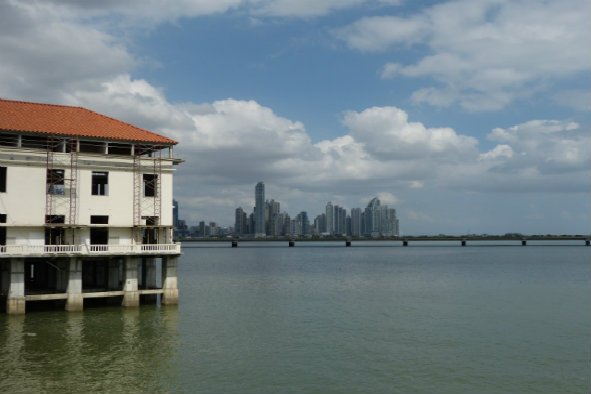
View of Panama City from Casco Viejo (Photo: R. Newman)
Surrounded on three sides by the Pacific Ocean, Casco’s seawall was built in the 1670s to protect the city from pirates. The old town area, also referred to as Casco Antiguo and San Felipe, has sweeping views of Panama City’s modern skyline, including a glimpse of Frank Gehry’s multicolored museum of biodiversity.
Once abandoned, the area, which is home to the Presidential Palace, is still a work-in-progress. The contrasts are part of its charm. With its cobblestone streets and narrow sidewalks, Casco’s 28 or so blocks are very walkable (which is not often the case in Panama City). Parking is limited and Panamanians have their own rules on the road, so leave the driving to Uber or taxis.
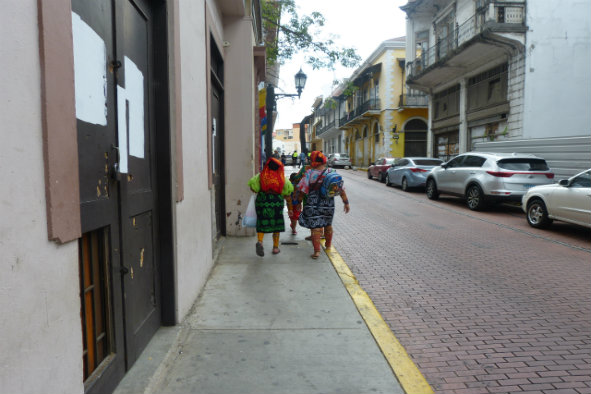
Guna Indians walking in Casco Viejo (Photo: R. Newman)
Even with Panama’s heat, Casco Viejo is a refreshing experience day or night. Here are a few fun stops and hot spots.
Restaurants and Cafes
Comida tipica (Panamanian home cooking) is best understood by wandering into a neighborhood fonda (smaller, cheaper diners) to check out what the locals are having. Chances are you’ll spot rice and plantains. Be on the lookout for bowls of sancocho– the soupy stew is a national dish made with seasoned broth, chicken meat and root vegetables. Most fondas are on the outskirts of Casco Viejo, but a few, like Fonda Leon (Avenida A between Calle 4 and 5 oeste) and Fonda Pritty Pritty (Avenida Central and Calle 3) are within the old town area. Pritty Pritty is especially popular with police, as a local precinct sits directly across the street.
Insider Tip: For foodies, rumor has it that a new fonda Lo Que Hay, meaning “whatever’s around” (Calle 5ta and Avenida A), is opening on Sundays only. This pop up fonda is the comfort food alternative from Panama’s hot new chef José Carles, whose sixteen-seat award-winning restaurant Donde Jose (1100 Ave. Central) serves a ten-course Panama-centric tasting menu and requires reservations many months in advance.
Panamanians have transformed the working seafood market El Mercado de Mariscos (Avenida Balboa & Calle Eloy Alfaro) into a gathering spot for lovers of ceviche, corvina and cerveza. Located at the foot of Casco Viejo and along the Cinta Costera (a coastal beltway), El Mercado boasts plenty of food booths blaring salsa music and serving fried and grilled fish along with some of Panama’s favorite side dishes, like patacones (fried plantain patties) and arroz con gandules (pigeon peas).
Inside a Casco Viejo ruin, another fish market experience awaits after dark. The Fish Market (Avenida B between Calle 8 and 9 Este) began as a food truck. Their new digs incorporate a bar, picnic tables and twinkling lights. The blackboard menu features seasonal and fresh seafood choices, which change frequently. The popular fish tacos, however, are always in demand. Note: Cash only.
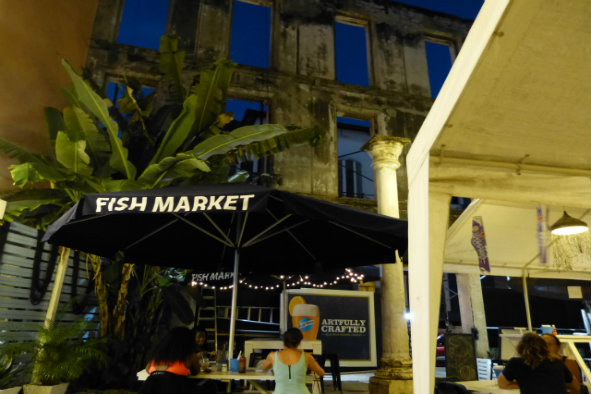
Fish market in Casco ruin (Photo: R. Newman)
For a fun taco experience with a tropical twist, head to Tacos La Neta (Calle 3era and Central) for “Los Tacos Tropicales de Panamá.” Chorizo queso, cochinita pibil (slow roasted pork) and carnitas are go-to choices for meat lovers. Fish and vegetarian options are also available, and the appealing prices make it easy to mix and match. The homemade hot sauces are innovative too, especially the Mole Unido, with coffee as a key ingredient. Wash it all down with aguas frescas or creative cocktails, like a Pineapple Sour or a Chica Mágica, a blend of flor de Jamaica and smoky mescal. Sweet tooth? Finish up with tres leches cake or a flan de caramelo or mole.
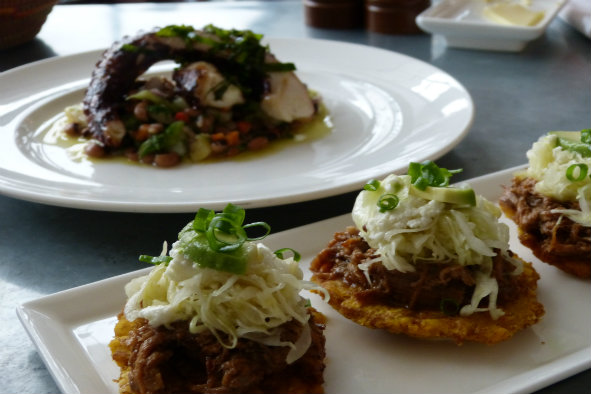
Pulled pork, plantains and octopus at The Dining Room, American Trade Hotel (Photo: R. Newman)
The American Trade Hotel (Avenida Central and Calle 8) is a symbol of Casco Viejo’s resurgence. Locals are drawn to this former gang denizen for many reasons, not the least of which is cultural pride. This five-story colonial style structure was the city’s first skyscraper, designed by a Panamanian architect in 1917. Today, in partnership with the Ace Hotel brand, it acts as a social hub, housing The Dining Room, one of Casco’s finest restaurants, as well as a vibrant lobby bar. Café Unidos, a craft coffee roaster, cafe and bakery, is attached to the hotel space, as is Danilo’s, a globally respected Jazz Club with a local commitment to developing young Panamanian talent.
Bars and Nightlife
Famous for its view and its vibe, the rooftop-bar at Tantalo (Calle 8 Este and Avenida B) comes alive at sunset and goes late into the night. It’s no wonder Panama’s most fashionable young party-goers flock to this venue. Their stated goal? To stimulate the senses. The restaurant’s food is noteworthy, as is its four-story live plant wall that thrives on reclaimed water. Tantalo’s mixologists capture the essence of Panama in every cocktail, using ingredients like yerbabuena, muddled watermelon and passionfruit pulp.
It would be easy to walk past Siroco (Calle 7 Este and Avenida B), with its random barber chair and small bar just past the entrance. Further inside, the whole picture changes. Two-stories of exposed brick surround an open-air dining space where chefs, on view in an open kitchen, transform octopus, lamb and lobster into foodie favorites. An air-conditioned room is also a first-floor dining option. Upstairs, a terrace lounge is perfect for stargazing, and a spacious indoor bar area is set up for dancing and entertainment.
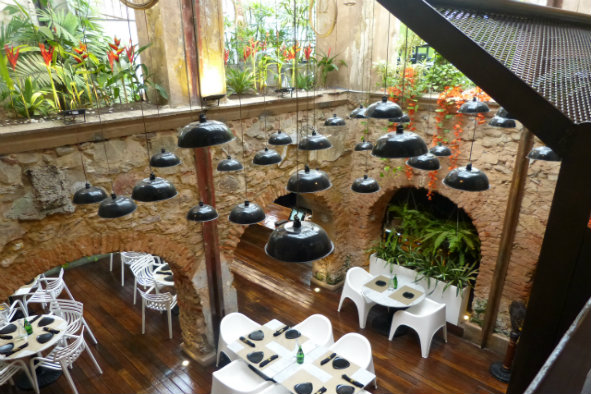
Siroco open air dining (Photo: R. Newman)
Raspadura, a type of unrefined sugar made from freshly concentrated cane juice, is what makes the rum at the Pedro Mandinga bar (Avenida A, between Plaza Herrera and Calle 8.) so special. The first artisanal rum distillery in Panama is named for an oft forgotten historical figure who escaped from slavery. Authenticity abounds. Tip: The late afternoon Happy Hour is an exceptional value. If beer is your thing, the same team is behind La Rana Dorada (Avenida Elroy Alfaro and Calle 11 Este), an excellent microbrewery at the entrance to Casco Viejo. Try a beer boat sampler for a taste of several local brews.
Sweets and Snacks
To cool off, try an authentic hand-shaved snow cone, known as a raspao, from one of the many street vendors. Or visit Rass Panama (Calle Ocho Este, Casa Morales) for a twist on this frozen favorite. The front grill of a Diablo Rojo, the brightly painted buses of Panama’s past, is selfie-bait and is used as the display case. The fun raspao flavor names dip into Panama’s diverse cultural mix, including the tamarind and ginger-flavored Bad Buay, a nod to West Indian Patois.
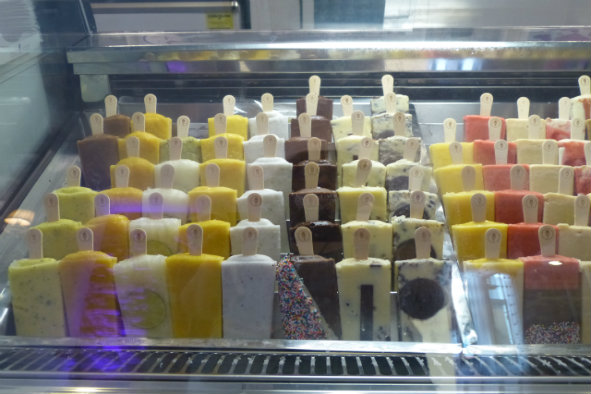
Paletas at Palettamerica (Photo: R. Newman)
The popsicles at Palettamerica (Calle 8 and Avenida B) are dripping with delicious creativity. Try the Panameña, a banana gelato pop with a Nutella center. Tropical fruit flavors like Maracuyá are frozen with a leche condensada (condensed milk) inside.
Artisanal chocolate shop and café Oro Moreno (Calle 6 and Avenida A) is making history in a historic location, the home of a former President. Founder Yoshiris Peña is pioneering the tree-to-bar process in Panama. Locally produced chocolate is teamed up with unexpected fillings like culantro and ají chombo, an herb and a pepper respectively.
Third Wave Coffee
Panama produces some of the finest coffee in the world. Until recently, however, it was exported globally with little attention to local consumption. Now, Casco Viejo is the epicentre of Panama’s third wave coffee cafes, like the aforementioned Café Unido at The American Trade Hotel.
Start your day at Casa Sucre Coffeehouse (Calle 8a Este and Avenida B), or enjoy breakfast all day at this renovated convent from the 1800s. Coffees include Panama’s finest and pair well with pastries or delightful tamales wrapped in banana leaves. Pick up some hard-to-find coffees to take back as gifts.
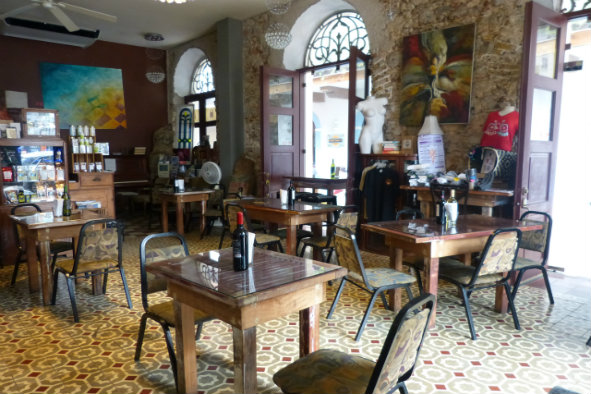
Café Sucre is housed in a former convent (Photo: R. Newman)
The smell of roasting coffee fills the air at the Bajareque Coffeehouse (Avenida Central and Calle 1), where their award-winning beans are roasted on site. Among them are Geisha beans, one of the world’s most expensive. The coffeehouse is owned by a family whose own fincas, or farms, are located in Boquete, Panama, a mountain town known for clean air and outstanding coffee.
Shopping
Young designers are emerging in Panama, and LUPA (Avenida A and Calle 5) is the place to find locally made clothing and artwork. An eclectic selection of books, posters and fun pop culture items are on display along with an on-trend, international selection of fashions, sunglasses and accessories.
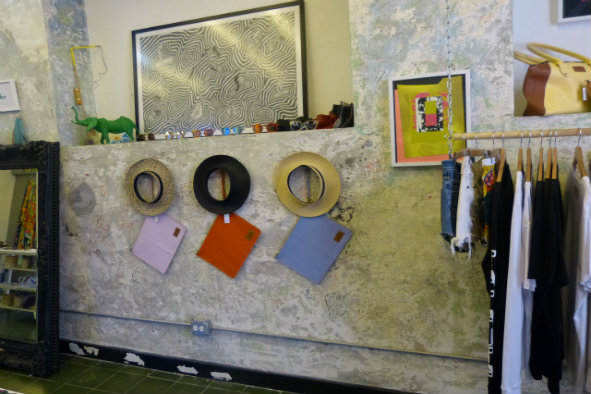
LUPA design store (Photo: R. Newman)
Molas, the iconic Panamanian handicraft sewn and worn by members of the Guna (aka Kuna) Indian tribe, are a must-have for visitors and locals alike. On Paseo Las Bóvedas, along Casco’s sea wall, Guna women display their work. (Tip: negotiating is expected). Now, in concert with indigenous designers, Franklin Panamá (Avenida B and Calle 7a Este) has taken mola patterns and applied them to scarves, ties, shoes and other luxury items. A portion of sales supports cultural preservation and education in the Guna Yala community.
Weil Gallery (Avenida A and Calle 3) is the go-to spot for work by local artists, canal zone collectibles and other one-of-a-kind finds. Panama’s diverse indigenous communities are represented with work from Wounaan, Embera and Guna tribes. This avant-garde gallery is known for its attention to research and authenticity; visitors can count on the knowledgeable sales staff for insight into the work on display.
Note: Travelers unfamiliar with the area are encouraged to avoid the outskirts and stick to Casco’s well-policed streets. Ex-gang members with deep community roots are available through Fortaleza Tours to provide an insider perspective on Casco’s post-Noriega transformation.